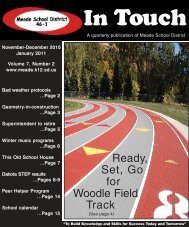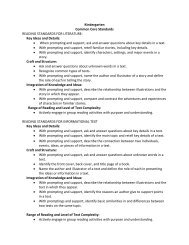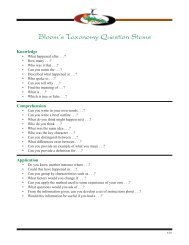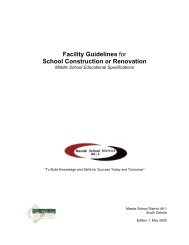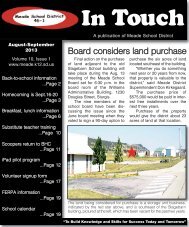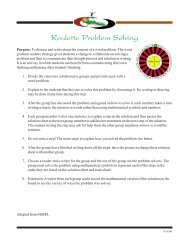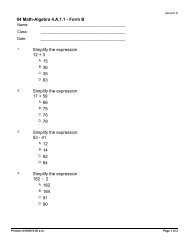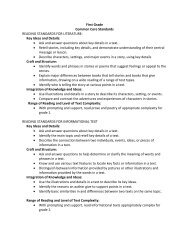<strong>Assessing</strong> Student’s <strong>Affect</strong> <strong>Related</strong> <strong>to</strong> <strong>Assessment</strong> <strong>for</strong> <strong>Learning</strong>W. James Popham and Rick StigginsScoring the Inven<strong>to</strong>riesRemember, results should be compiled <strong>for</strong> the class as awhole so as <strong>to</strong> identify patterns or, over time, trends inresponses. One easy procedure is <strong>to</strong> determine the numberof students who select each response <strong>to</strong> each item. Thisprocedure may work best when the teacher is just doing aquick check <strong>to</strong> determine the current state of affairs in theclass. Then make a simple bar graph <strong>for</strong> each item. How dothe students’ responses distribute themselves along the“agreement-disagreement” response scale? The patterns willusually reveal students’ sentiments. .But if the teacher seeks <strong>to</strong> track changes in students’affect over time, frequency counts and bar graphs can beclumsy. It is typically better in that case <strong>to</strong> calculate averageratings so the teacher can detect changes in students’ scoresover time. To convert the frequency counts <strong>to</strong> averagescores, simply multiply the score (1 <strong>to</strong> 5) by its frequency,add the resulting calculations across scores and divide bythe <strong>to</strong>tal number of students responding. This should bedone <strong>for</strong> each individual item separately.To compute an academic efficacy score based on thecombined positively and negatively stated items, rememberthat scores on a positively stated item go from 1 <strong>for</strong> astrongly-disagree response <strong>to</strong> a 5 <strong>for</strong> a strongly agreeresponse. But on a negatively phrased item, the scale isreversed. The higher the score, the more “appropriate” is theresponse. Because there are two items per variable, a pervariablescore can range from a low of two points <strong>to</strong> a highof ten points. Here is a graphic illustration of the scoregeneratingprocess:Item Rating scale Combined <strong>for</strong> each score1 5 4 3 2 1 Clarity of <strong>Learning</strong> Targets2 5 4 3 2 13 1 2 3 4 5 Eagerness <strong>to</strong> Learn4 5 4 3 2 15 1 2 3 4 5 Academic Efficacy6 1 2 3 4 57 1 2 3 4 5 Progress Moni<strong>to</strong>ring8 5 4 3 2 1 In<strong>for</strong>mationAdjusting Instruction Based on ResultsWe begin this section with two cautions. First, thestrategies suggested <strong>for</strong>m the foundation of an AFLclassroom. The vast majority of teachers have not been giventhe opportunity <strong>to</strong> learn how <strong>to</strong> create such environments.The creation of an AFL requires a fundamentalunderstanding of several principles that we can merelyhighlight herein. Those interested in further study of theprinciples, strategies, and tactics outlined below shouldconsult one or more of the numerous articles and books nowbeing published regarding AFL.Second, we assume that the teacher’s (inven<strong>to</strong>ry-user’s)goal is <strong>to</strong> help the largest possible proportion of theirstudents meet pre-specified academic achievementstandards. That is, the mission is <strong>to</strong> maximize studentsuccess. The AFL suggestions offered below can have thatimpact. If the teacher’s mission is something other, such as<strong>to</strong> produce a dependable rank order of students at the end ofinstruction, the suggestions offered may becounterproductive.If an inven<strong>to</strong>ry’s results suggest that students’ sense ofacademic efficacy is lower than desired on the basis of asingle administration of a grade-appropriate inven<strong>to</strong>ry, or isnot tending upward on repeated measures over time, theninstructional actions need <strong>to</strong> help students gain a sense ofcontrol over their learning success. This requires thatclassroom practices get students on academic “winningstreaks” and keep them there. Six specific strategies appliedin this order can help with this:1. Provide learners with student-friendly versions ofthe achievement targets from the very beginning ofinstruction.<strong>Learning</strong> accelerates when teachers describe what goodwork looks like using vocabulary that learners canunderstand. Students can hit any target that they can see andthat holds still <strong>for</strong> them. With clear signposts be<strong>for</strong>e them,students can watch themselves progressing ever closer <strong>to</strong>success. This builds confidence. When this frame ofreference is missing <strong>for</strong> them, students can lose their wayand their ability <strong>to</strong> find the path <strong>to</strong> success. Obviously, thissuggestion places a premium on teachers’ having clear andappropriate achievement expectations, that is, the suggestiondepends on teachers’ knowing where they’re going.2. Accompany those expectations with samples ofstudent work that reveal <strong>to</strong> students, from thebeginning of the learning, what their work will looklike as it improves.Those samples should cover the full range, includingweak, mid-range, and high-quality work. Again, this allowslearners <strong>to</strong> evaluate where they are at any time on thecontinuum of achievement in relation <strong>to</strong> where teachers wantThis version released through The Council of Chief State School Officers4The FAST SCASS • Formative <strong>Assessment</strong> <strong>for</strong> Students and Teachers
<strong>Assessing</strong> Student’s <strong>Affect</strong> <strong>Related</strong> <strong>to</strong> <strong>Assessment</strong> <strong>for</strong> <strong>Learning</strong>them <strong>to</strong> be. As students see the fruits of their ef<strong>for</strong>ts inlearning results, academic efficacy grows.3. Provide students with continuous access <strong>to</strong>descriptive feedback, that is, with feedback showingthem now <strong>to</strong> do better the next time.In effect, this suggestion gives students control in the<strong>for</strong>m of the in<strong>for</strong>mation needed <strong>to</strong> keep them moving alongthe learning progression relevant <strong>to</strong> the achievement targetbeing pursued. Teachers should want their students <strong>to</strong> winearly, win small, and win often. Winning streaks becometrajec<strong>to</strong>ries that take on a life of their own. Confidence andoptimism grow. And, of course, teachers must be sure thatclassroom assessments are of sufficient quality <strong>to</strong> provideteachers and their students with accurate in<strong>for</strong>mation.4. Teach students <strong>to</strong> self assess so they can begin <strong>to</strong>generate their own descriptive feedback.This suggestion requires that students learn <strong>to</strong> apply thevery same per<strong>for</strong>mance criteria their teachers apply whenevaluating students’ work. By getting students <strong>to</strong> play a rolein this process, teachers set students up <strong>to</strong> become partners indetermining what comes next in their learning, that is, insetting goals and in defining success. This contributes <strong>to</strong>students’ sense of control over their success.5. Help students learn <strong>to</strong> improve their work one keyattribute of success at a time.By not overwhelming students with <strong>to</strong>o many neededimprovements, teachers can help their students succeed bytaking baby steps and, continuously, building an internalsense of control over their success. Winning streaks feelgood, and this builds confidence.6. Teach students <strong>to</strong> reflect on changes(improvements) in the quality of their work and whythose improvements have happened.This suggestion represents the culmination of what isaccomplished by applying Suggestions 1 <strong>to</strong> 5 above. Bydeveloping an understanding of the key attributes of goodwork as reflected in actual samples of that work, teachersgive students the <strong>to</strong>ols needed <strong>to</strong> see key changes inW. James Popham and Rick Stigginsstudents’ own work. By giving descriptive feedback, one keyattribute at a time, and helping students learn <strong>to</strong> generatetheir own feedback, teachers give students a mirror in which<strong>to</strong> see themselves climbing <strong>to</strong>ward success. All of this putsstudents in <strong>to</strong>uch with their own evolving academiccapabilities. In effect, success becomes its own reward.With the resulting sense that success is, in fact, withinreach, students’ academic efficacy and eagerness <strong>to</strong> learnwill increase. But the foundational conditions are thatstudents be in <strong>to</strong>uch with the targets from the beginning ofthe learning, and that students have access <strong>to</strong> their owncontinuous record of assessment results so they navigate thepath <strong>to</strong> success and watch themselves arriving there. It issurprising how effectively success builds eagerness <strong>for</strong> moresuccess.Concluding RequestThe current version of these introduc<strong>to</strong>ry remarks andthe three affective inven<strong>to</strong>ries are being distributed on alimited basis with the hope that some educa<strong>to</strong>rs may choose<strong>to</strong> employ them and, based on those experiences, relaysuggestions <strong>to</strong> us regarding how <strong>to</strong> improve either theinven<strong>to</strong>ries themselves or the introduction <strong>to</strong> their use. If youhave suggestions, please relay them <strong>to</strong> : rstiggins@ets.org orwpopham@ucla.edu.ReferencesBlack, P. and D. Wiliam (1998a). “<strong>Assessment</strong> andClassroom <strong>Learning</strong>,” <strong>Assessment</strong> in Education:Principles, Policy and Practice 5(1): 7-73; alsosummarized in “Inside the Black Box: RaisingStandards through Classroom <strong>Assessment</strong>,” PhilDelta Kappan. 80(2), 139-148.This version released through The Council of Chief State School Officers5The FAST SCASS • Formative <strong>Assessment</strong> <strong>for</strong> Students and Teachers



